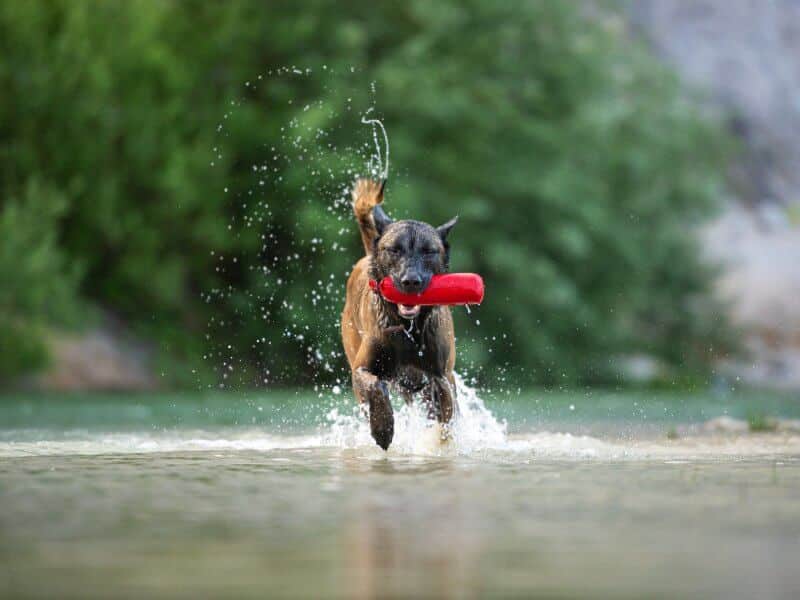Strength is needed in every dog sport, from Conformation to Earthdog and all the sports in between. Strength is also strongly correlated with increased longevity in dogs, and we all want that! Many people think that the best way to strengthen their dogs is to take them for a walk. However, although walks provide excellent “Good for the Soul” exercise, with abundant sensory stimulation—sights, smells, sounds, new surfaces, and even some tasty treats (either served by you or discovered in the environment), they do not increase your dog’s strength. Even if you also train your dog in one or more sports and play fun games like retrieving, those activities still do not improve strength.
A typical strength exercise for humans is weightlifting. Since dogs don’t have opposable thumbs, they tend to “drop the barbells.” So, for canine strength exercises we use the dog’s body as the weight instead. Strength exercises require that the dog moves its body over short distances, accelerating, decelerating, turning, etc. The table below lists some strength activities and the sports that require those activities. These examples demonstrate just how important strength is to active dogs.
Canine Strength Activities and Related Sports
Strength Activities
|
Sports
|
| Acceleration |
Most Sports, Working Dog Jobs, and Dog Games |
| Deceleration |
Most Sports, Working Dog Jobs, and Dog Games |
| Turning |
Most Sports, Working Dog Jobs, and Dog Games |
| Stopping |
Most Sports, Working Dog Jobs, and Dog Games |
| Jumping |
Agility, Flyball, Obedience, Rally, IPO,
Police/Military Work, SAR |
| Driving through Vegetation, Muddy Water and/or Other Environmental Obstacles |
Hunt Tests, Field Trials, Tracking,
Police/Military Work, SAR |
| Carrying an Object |
Hunt Tests, Field Trials, Obedience, IPO,
Retrieving Games, Police/Military Work |
| Pulling against a Harness |
Tracking, Mushing, Police/Military Work,
SAR, Assistance Dog |
Lying Down &
Getting Up Repeatedly |
Herding |
| Heads-Up Heeling |
Obedience, Rally, IPO |
| Bitework |
IPO, Police/Military Work, Tugging Games |
Strength exercises require that the dog moves its body over short distances, accelerating, decelerating, turning, etc. The table below lists some strength activities and the sports that require those activities.
STRENGTH MEANS SPEED
Strength is directly related to speed. If you want your dog to be fast at any sport or working job (Conformation, Agility, Flyball, Obedience, Rally, Hunt Tests, Field Trials, Lure Coursing, Herding, Fast CAT, Barn Hunts, Nosework/Scentwork, IPO, Police/Military Work, and Search and Rescue all reward speed), then your dog needs to be strong.
STRENGTH MEANS FEWER INJURIES AND A LONGER HEALTH SPAN
Strong adult dogs have a 66 percent reduced risk of injuries, and strength training definitely increases the longevity of senior and geriatric dogs. Sadly, many dogs are euthanized every year because they can no longer climb stairs, retain their balance on slippery floors, or even stand up from a down position. For the vast majority of these dogs, strong core and rear leg musculature would allow them to retain their quality of life for months or even years longer.
Strong adult dogs have a 66 percent reduced risk of injuries, and strength training definitely increases the longevity of senior and geriatric dogs.
WHERE TO START?
Just as with people, most dogs have weak core muscles. One of the best strength exercises for the core is teaching your dog to sit up on its haunches. This exercise can really pay off in preventing injuries in active dogs! In addition to targeting the core muscles, the sit-up requires no equipment (except delicious treats), can be performed indoors when the weather outside is nasty, and is non-concussive, so you are not adding more impact to your dog’s already active life.
But wait a minute! Maybe you heard that this exercise was not safe for dogs. Some sites on the Internet say that you should NEVER do this exercise with dogs because it would put too much pressure on the joints of the spine.
When I heard that rumor, I did what everyone should do—I looked for the scientific evidence. I found a published study where the amount of pressure on the spine was measured when dogs were sitting up on their haunches. And guess what? A dog puts two to three times more pressure on the joints of the spine by just standing still, going up or down stairs, or going from a sit to a stand than when sitting up on the haunches. That puts any concerns about this exercise being dangerous to rest. Of course, this exercise should not be performed with a dog that has any condition that causes back pain—those dogs need a diagnosis to determine the cause of the pain, which would then be directly addressed.
HOW TO TRAIN THE SIT-UP
This is a difficult exercise for many dogs initially, so progress slowly through the stages, only gradually making the exercise more difficult. Do not practice any more often than every other day. Progress through these instructions step-by-step, not skipping any.
- Start with your dog sitting and nibbling treats—always have your dog nibbling treats throughout this exercise.
- Move the food backward and just a little bit upward to a position where it is over the base of your dog’s tail so that the spine is perpendicular to the floor. Don’t hold the food so high that your dog has to stretch its neck or stand up to reach the food.
- If your dog moves away or tries to stand up, quickly put the food behind your back and look away.
- After a moment, try again. Your dog will soon learn they won’t get treats for other types of movement.
- Many dogs are initially too weak to get their front feet off the ground, so give your dog a treat just for lifting one foot slightly off the ground, then for two feet. After 7 to 10 days of trying, dogs usually have built up enough muscle to be able to sit up with both front feet off the ground.
- Keep working the exercise until your dog can do three 15-second sit-ups, with 5-second breaks in between.
Next, try to lure your dog off balance using various methods:
- Move the food side to side, back and forth, up and down.
- Push on your dog’s chest from the sides, front, and back.
- To strengthen your dog’s core muscles further, you can move the exercise from a solid surface to working on a soft, flat surface like a bed, ottoman, or folded stack of blankets.
- Next, progress to working on hills (facing a different direction each session). The muscles that are facing uphill do the most work.
Work this exercise only until your dog is panting. If your dog cannot do three 15-second sit-ups, stop for the day and try again in the next session.
As you and your dog share life’s activities, and as your dog ages and continues to be able to climb stairs, get into your vehicle, and get onto your bed at night, you will be so grateful that you spent just a few minutes several times a week engaging in strength-building activities.
Videos demonstrating dozens of non-impact strength exercises that are targeted to the front legs, rear legs, and core can be obtained at: https://caninesports.com/product/ffl-videos/ or https://vimeo.com/ondemand/caninefitforlife.









